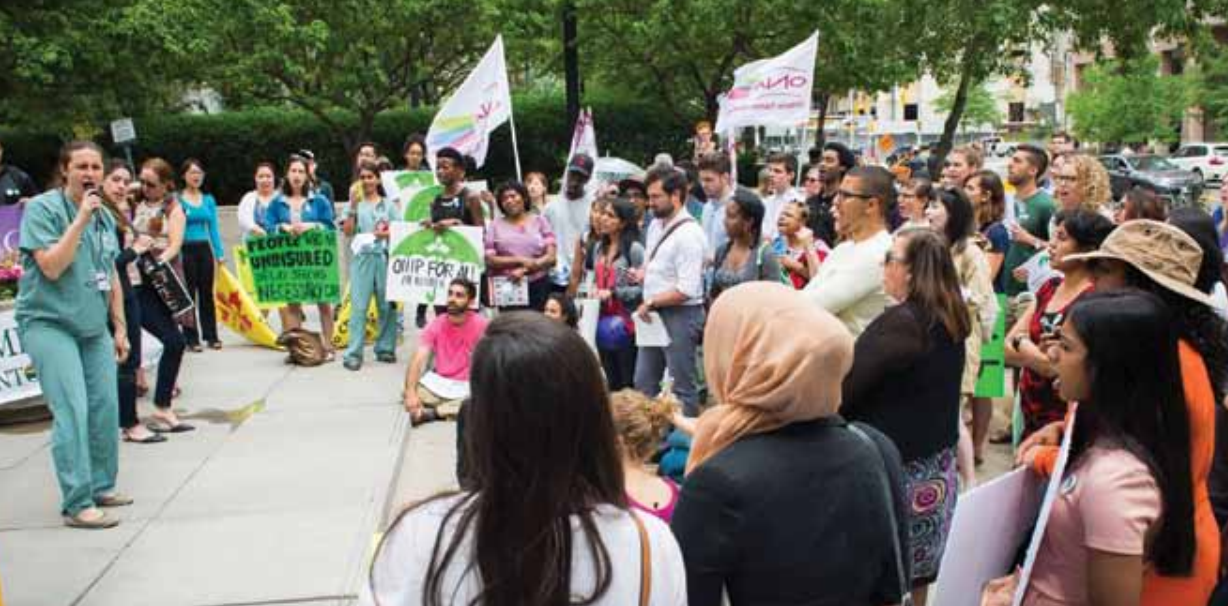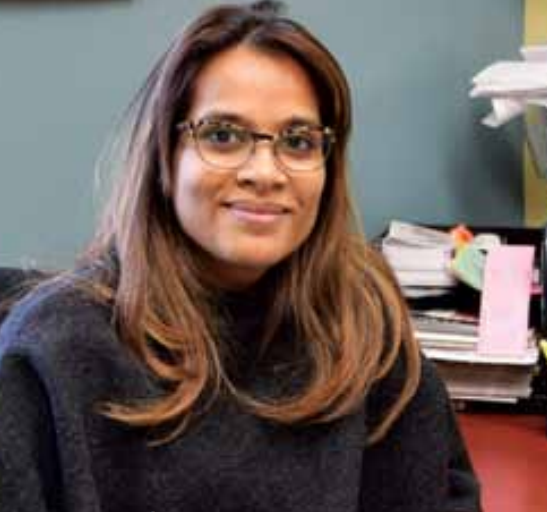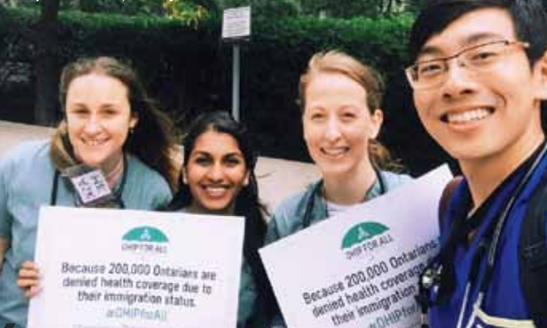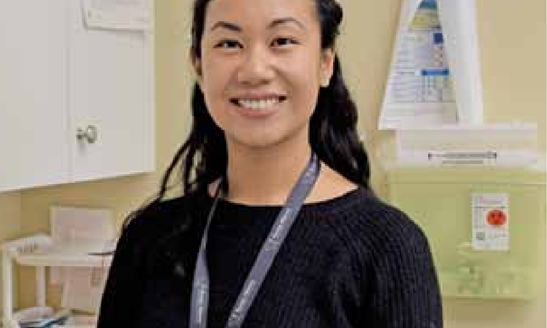
On a gloomy February evening, the pink, yellow and blue walls of Toronto’s AccessPoint on Jane are lined with occupied chairs.
Children of various ethnic backgrounds explore the small community health centre (CHC) waiting room and meet new friends. Three young men with Caribbean accents discuss the latest basketball news. And a diverse group of patients – one of whom is wearing a Canada-branded toque – mull around the front desk.
Mondays and Thursdays draw big crowds to this west-Toronto location of Access Alliance Multicultural Health and Community Services, tucked inside the second floor of an otherwise quiet plaza on Jane Street. RN Sideeka Narayan is behind the desk helping the secretary check patients in during the 4 p.m. rush. At the front of the line is a middle-aged Afghan couple, whose young son is rifling through public health pamphlets in every language from French to Nepali.
The couple arrived in Canada two days earlier with their four children, hoping to make a refugee claim. In the meantime, their kids need to see a health-care provider. Though they speak limited English, Narayan is able to ask them a few key questions. Do they have a permanent address? Do they have a phone number where the clinic can reach them? Do they have health insurance? The answer to all three questions is no. “Okay, we’re still going to go ahead and see them,” Narayan tells the secretary, before asking her to ring up a Farsi interpreter.
That’s pretty much the ethos on Monday and Thursday evenings at AccessPoint on Jane, when Access Alliance runs the Non-Insured Walk-in Clinic (NIWIC). Since 2012, the clinic has been offering primary health care to Ontario residents who are not covered by the Ontario Health Insurance Plan (OHIP). Though Access Alliance operates the clinic, it was created in collaboration with six other Toronto CHCs as a way of combining the limited resources each receives to treat non-insured patients, and of streamlining access to care. With an NP and RN on site, NIWIC works with more than 500 patients a year, providing episodic care, treating chronic illnesses, doing health promotion, and connecting people with other resources in the community.
But Narayan says CHCs alone cannot meet the needs of Ontario’s uninsured population, especially in smaller communities across the province. NIWIC saw a 30 per cent increase in patients in 2016-17, and with uncertainty surrounding immigration and refugee policy in the U.S., Narayan expects the patient roster to continue to grow. To find a more sustainable solution for uninsured Ontarians, she is part of a large network of nurses and other health professionals advocating to give everyone residing in Ontario access to health insurance.
Health care is a human right. So what are we going to do as a system to make sure everyone has a similar level of access?”
“This is a huge equity issue,” says Narayan, who manages the clinic as part of her portfolio in Access Alliance’s Health with Dignity program. “Health care is a human right. So what are we going to do as a system to make sure everyone has a similar level of access?”
Though Canadians pride themselves on having a universal health system, it is estimated as many as 500,000 Ontario residents live without health insurance. There are various reasons people are not covered by OHIP. Many are newcomers to the country who don’t have immigration status because they overstayed their visa or had it taken away. Others have come to Ontario as immigrants or temporary workers and are in the three-month waiting period before OHIP kicks in. And many asylum seekers fall through the cracks of the refugee system, and thus don’t qualify for the Interim Federal Health Program (IFHP).
NIWIC’s patients come from all corners of the world. Portugal, Brazil, Mexico, Nigeria and Jamaica (in that order) are their most common countries of origin. They’re a diverse group, and for the most part, Narayan says they came to Canada seeking a better life. “These are people who are escaping poverty, abuse, violence, and may not have access to the most basic necessities of life, “ she explains.
But without insurance in Ontario, their options for health care are limited and costly. If they’re forced to go to hospital to treat an acute illness or to deliver a baby, they will likely leave with a hefty invoice for the health services they received, plus administration fees. In Narayan’s experience, health-care bills can be as high as $10,000 – a huge barrier for NIWIC patients, 35 per cent of whom report having an annual household income under $20,000.
Potentially exorbitant charges for health care force many uninsured Ontarians to avoid health professionals. Even where options like NIWIC exist, many people are not aware of them, or they fear being deported if they do not have immigration status. By the time some uninsured people seek health care, what could have been a small, preventable issue might be a lot more complicated, says NIWIC RN Monika Dalmacio.
To keep people healthy, Dalmacio and her colleagues promote preventive care and make sure they inform uninsured clients about their rights. When they have to refer a client elsewhere, they try and send them to providers who will not charge a fee. Dalmacio takes pride in advocating on behalf of her clients, and part of that advocacy is raising awareness about the challenges of living without insurance. She says many people aren’t even aware this population exists. “When I share information about the work that I do, the first question is often: ‘doesn’t everyone have health insurance?’”
If RN Melanie Spence gets her wish, everyone will.
Spence is a community health nurse in Toronto, where she regularly encounters people without OHIP. She moved back to Ontario from B.C. in 2012, the same year Stephen Harper’s Conservative government made cuts to IFHP that would leave many refugee claimants without access to health care. In response, she became active in the grassroots organization, Health for All, which advocated reversing the cuts. RNAO was vocal on this issue as well, securing standing in court to fight against the cuts. When IFHP coverage was restored by the Liberal government in 2016, Health for All turned its sights on getting health insurance for the half-a-million Ontario residents without it. The resulting OHIP for All campaign is calling on government to eliminate the three-month OHIP waiting period, and to provide coverage to Ontarians who lack it due to their immigration status
On one level, (the OHIP for All campaign) is about human dignity and deservedness. On another level, it’s about recognizing the varied and valuable contributions that everyone makes when they make a home here.”
“On one level, (the OHIP for All campaign) is about human dignity and deservedness,” Spence explains. “On another level, it’s about recognizing the varied and valuable contributions that everyone makes when they make a home here. These are people who are building our buildings, who are looking after our children, and who are our coworkers, neighbours and friends.”
Advocacy has become a major part of Spence’s nursing practice, and she believes all nurses can be integral in making OHIP for All’s vision a reality. “As nurses...I think we have an obligation to be part of the broader conversation around making changes to the system when health is at risk.”
RNAO has been a strong supporter of OHIP for All since the campaign’s inception two years ago. In December 2016, the association sent a letter to then health minister Eric Hoskins asking for a comprehensive plan to give OHIP coverage to all Ontario residents. It was followed up with an action alert in 2017 urging Hoskins and Premier Kathleen Wynne to eliminate the three-month waiting period for OHIP as a first step toward that goal.
RN Lynn Anne Mulrooney, RNAO’s senior policy analyst, led much of the association’s work on this issue. Having spent two decades nursing and studying abroad in Africa and the U.S., where she saw people struggle to access health care, Mulrooney is disheartened to see the same struggles among newly landed immigrants in Canada. “Access to health care is...a duty we have to each other as human beings,” she says. “I feel ashamed that we know this and still are willing to gamble with people’s lives.”
As nurses and other advocates continue to fight for expanded OHIP coverage, people like Alice* are left with few places to turn. A young woman in her 20s, she came to Canada from the Caribbean with her partner, who promised to sponsor her for a visa. The relationship turned abusive, and Alice’s partner took away her visa papers. She ended up living in a shelter without immigration status.
When she came to NIWIC in 2014, Alice was pregnant in her third trimester. Soon afterward, she disclosed she was HIV-positive. “She had been off her cocktail of medications for quite some time since she had been living here,” Narayan recalls.
The clinic was able to connect Alice with a program for pregnant, HIV-positive women at another health-care organization. She was seen by a midwife and an obstetrician, and the OHIP costs were covered through NIWIC. Though Alice had complications with her pregnancy and during delivery, she was discharged with a healthy baby boy.
“Had (NIWIC) not existed...she might have shown up in the emergency department and not disclosed her HIV status...and there would have been a high risk of transmission to that child,” Narayan says. “If we didn’t have the clinic, (people without insurance) wouldn’t have access to much else.”



